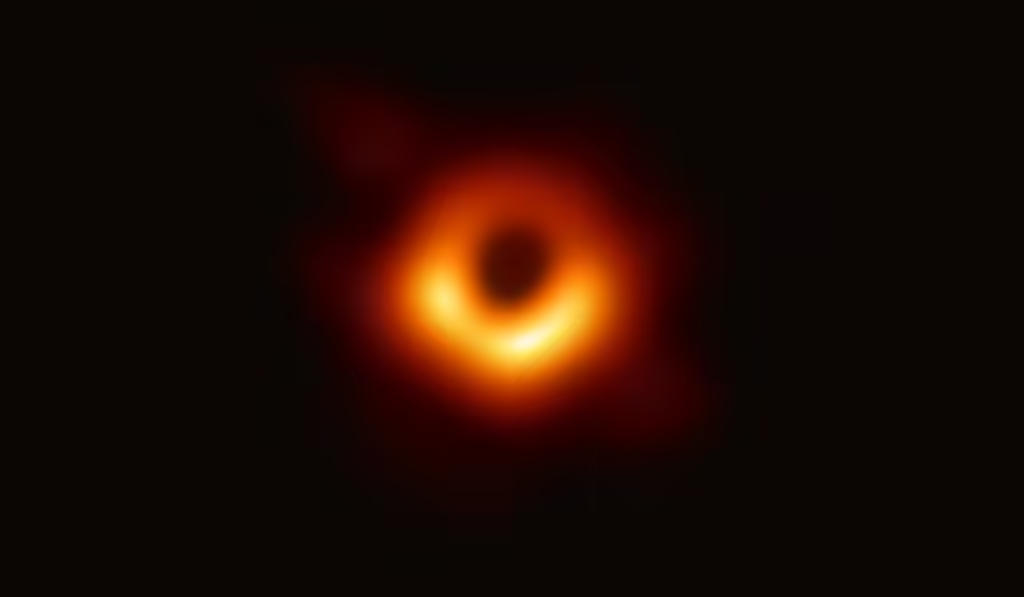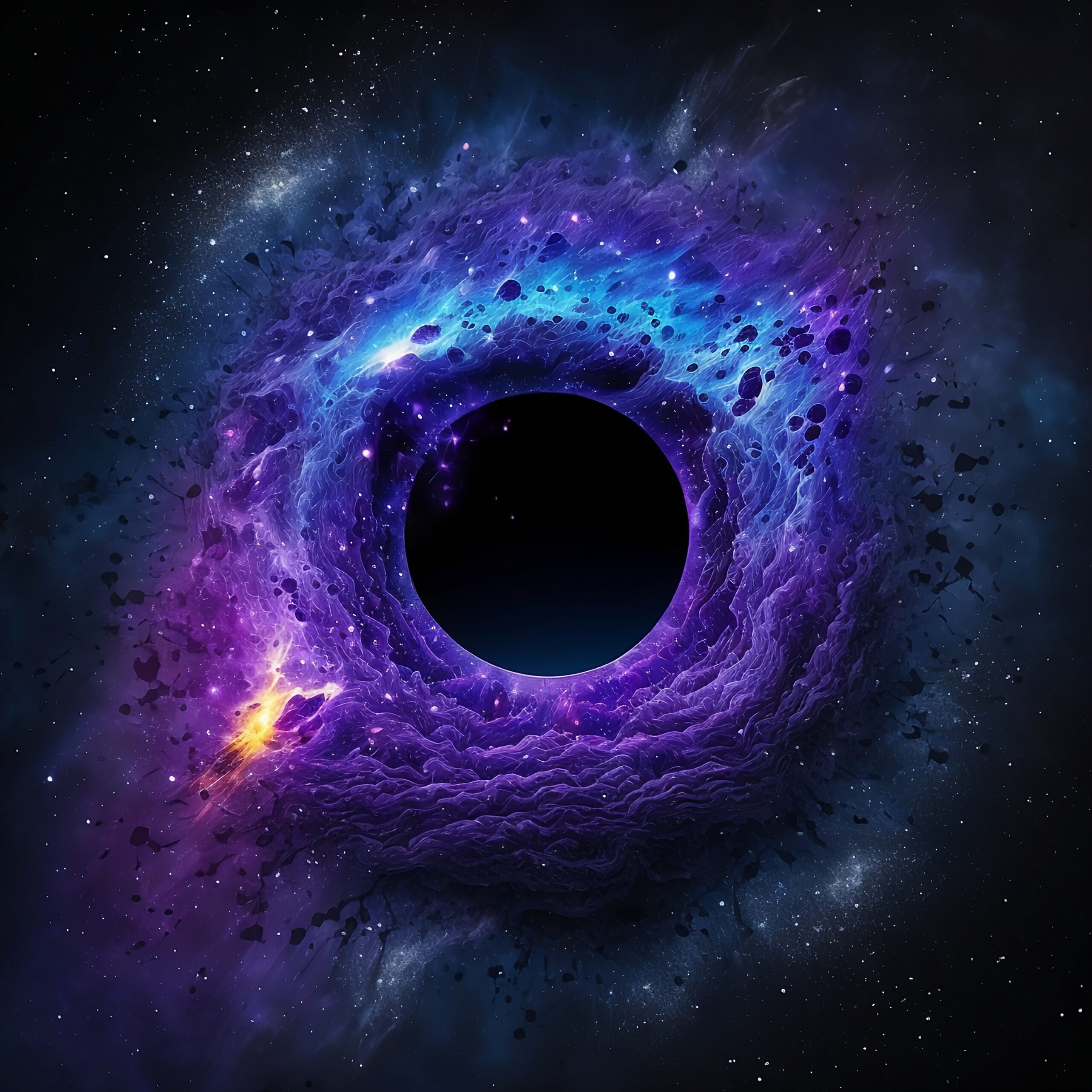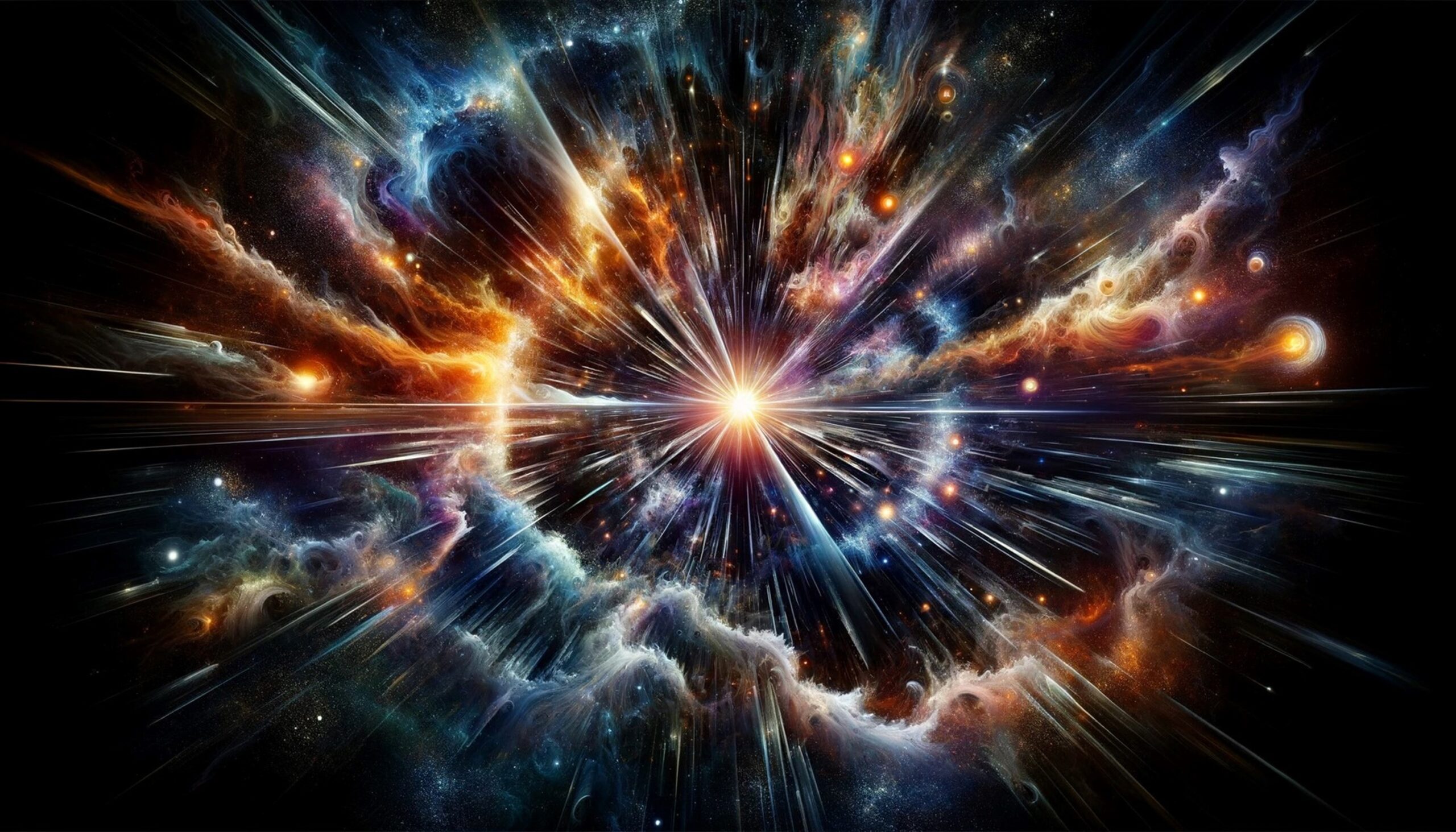- Introduction
- Formation of a Black Hole: How Do They Come to Exist?
- Types of Black Holes
- The Event Horizon: The Point of No Return
- Spaghettification: What Would Happen to Matter?
- The Singularity: Where the Laws of Physics Break Down
- Hawking Radiation: Can Anything Escape a Black Hole?
- Conclusion: The Quest to Understand the Darkness
Introduction
Black holes are some of the most interesting and mysterious things in the universe, capturing the attention of both scientists and the public. They form when large stars collapse, squeezing all their material into a tiny, incredibly dense point called a singularity, where gravity is extreme. At this point, the usual rules of physics don’t apply as we expect.
The main feature of a black hole is its event horizon—a boundary where nothing, not even light, can escape its pull. If you cross this line, you enter a place where space and time behave in strange ways. The big mystery is what happens once you go beyond the event horizon: What is inside a black hole? What would you find if you could reach its center?
Formation of a Black Hole: How Do They Come to Exist?
Black holes form from the dramatic deaths of massive stars. Stars balance the outward force from nuclear fusion in their cores and the inward pull of gravity. However, when a star much larger than our Sun runs out of fuel, it can’t fight gravity anymore. This leads to a process called gravitational collapse, where the star’s core collapses under its weight, creating a very dense point. This is how a black hole is born.
During this collapse, the outer layers of the star might explode in a supernova, leaving a dense core behind. If this core is heavy enough, gravity will pull it into an extremely small area, forming a singularity—a point where density is infinite and space-time is curved dramatically. Surrounding this singularity is the event horizon, an invisible boundary where nothing, not even light, can escape the black hole’s pull. The event horizon marks the “surface” of a black hole and defines a region where time and space behave in ways we can’t fully understand.
Types of Black Holes
There are several types of black holes, mainly based on their mass and how they formed. The main types are:
Stellar Black Holes
These are the most common types, created from the collapse of individual massive stars. Stellar black holes typically have masses from a few times to dozens of times that of the Sun and are only a few kilometers wide. Even though they are small, their gravitational pull is incredibly strong.
Supermassive Black Holes
Located at the centres of most galaxies, including our Milky Way, these giants can weigh millions or even billions of times as much as the Sun. Supermassive black holes probably formed in the early universe and grew by collecting matter over billions of years. Their event horizons can be as large as our entire solar system, but far from their cores, they have a relatively gentle gravitational pull.
Intermediate Black Holes
Recently discovered and still not well understood, intermediate black holes are thought to have masses between stellar and supermassive black holes. They might form from the collisions of stellar black holes or through other unknown processes. They could be the “building blocks” that eventually merge to create supermassive black holes.
Primordial Black Holes
These hypothetical black holes may have formed during the Big Bang. They would be much smaller than stellar black holes and could range from tiny sizes to those similar to planets. While they haven’t been confirmed, studying them could help us learn about the early universe.

Structure and Size Differences
The size of a black hole affects how it interacts with the space around it. Stellar black holes are compact and have very strong gravitational forces, meaning that as you get closer to the event horizon, gravity changes dramatically. In contrast, supermassive black holes have a gentler gravitational pull at the event horizon, which might allow objects to cross it without being ripped apart.
Each type of black hole helps us understand the universe better, from stellar black holes that teach us about stars’ lives and deaths to supermassive black holes that shape galaxies and may hold secrets about the early cosmos.
The event horizon of a black hole is often referred to as the “surface” that separates the black hole from the rest of the universe. However, it’s not a physical surface; it’s more like a mathematical boundary in space-time. Once something crosses this boundary, it cannot escape the black hole’s gravitational pull—this includes light, which is the fastest thing in the universe. That’s why we call it a “black hole”: any light that comes from inside this boundary can’t reach anyone outside.
The Event Horizon: The Point of No Return
One-Way Boundary
The event horizon acts as a one-way boundary. For someone falling into a black hole, crossing the event horizon means reaching a point of no return. It might seem like they could turn back as they get closer, but the extreme gravity prevents any escape. As you approach the event horizon, the pull of gravity becomes stronger, making it impossible to go back. This one-way nature highlights the dramatic and trapping qualities of black holes.
Experiences Near the Event Horizon
As a person gets closer to the event horizon, they would encounter several interesting physical effects, mostly based on the principles of general relativity. Here are some key experiences:
Time Dilation
According to Einstein’s theory, time doesn’t pass the same way in different gravitational fields. As someone nears the event horizon, time would seem to slow down for them compared to someone watching from a distance. To the person falling in, time feels normal, but to the outside observer, they would appear to move slower and slower. Eventually, they would seem to freeze at the horizon, taking an infinite amount of time to actually cross it.
Gravitational Redshift
Light coming from an object falling into a black hole gets stretched out, a phenomenon known as gravitational redshift. For someone watching from afar, the light signals from the person falling in would lose energy and shift toward the red end of the spectrum. As the observer gets closer to the event horizon, their light becomes increasingly redshifted until it fades away completely.
Spaghettification
Near the event horizon, especially in stellar black holes, the difference in gravitational pull between the parts of a body that are closer to the black hole and those that are farther away can be extreme. This difference in gravity, called tidal forces, would stretch and squish objects into a long, thin shape, a process humorously called “spaghettification.” If someone were falling into a black hole, they would be pulled apart lengthwise and compressed from side to side.
Visual Distortions
As one approaches the event horizon, the strong gravitational field would warp space-time, causing unusual visual effects. Light from stars and objects behind the black hole would bend around it, creating a distorted view of the universe. An observer falling toward the event horizon might see the universe collapse into a bright ring known as the photon sphere, where gravity is strong enough to make light orbit the black hole.

Spaghettification: What Would Happen to Matter?
These phenomena show not only how strange black holes are but also how gravity can change our understanding of time and space. Learning about what happens at the event horizon and how observers experience it helps us grasp the fundamental principles of our universe, challenging our ideas of reality and expanding our understanding of physics at extreme levels.
Spaghettification, often humorously called “noodle-ization,” happens when an object falls into a black hole and experiences extreme gravitational forces that stretch it vertically while compressing it horizontally. This effect arises from the strong differences in gravity near a black hole, especially as you approach the event horizon.
Understanding Spaghettification
To picture spaghettification, think of an elastic band being pulled at both ends. As you stretch it, the band elongates and becomes thinner in the middle. Similarly, when an object gets close to a black hole, the gravitational force pulling on the part of the object that is nearer to the black hole is much stronger than the pull on the part that is farther away. This difference in gravitational pull is called the tidal force.
For example, imagine a person falling feet-first into a black hole:
Vertical Stretching: The gravitational pull on their feet would be much stronger than the pull on their head. As they near the event horizon, their feet are pulled downward with great force, causing their body to stretch out, much like how spaghetti elongates when pulled.
Horizontal Compression: At the same time, the part of their body farther from the black hole (their head) feels a weaker gravitational pull, causing their body to compress horizontally. This results in an overall elongation, turning the person into a thin, elongated shape like spaghetti.
The Singularity: Where the Laws of Physics Break Down
The singularity is one of the most mysterious and perplexing aspects of black holes. It is a point of infinite density where gravitational forces are so extreme that our current understanding of physics breaks down. Essentially, the singularity is where the known laws of physics no longer work, and we can’t predict what happens.
Understanding the Singularity
In a black hole, the singularity is located at the core, surrounded by the event horizon. This point represents a place where matter is crushed into an infinitely small space, leading to infinite density and severe curvature of space-time. At the singularity, our usual ideas about space and time lose their meaning, creating a region that is fundamentally different from anything we know in our universe.
Limitations of General Relativity
Einstein’s theory of general relativity explains gravity as the bending of space-time caused by mass. This theory works well for understanding large-scale astronomical events, like how planets move and how light bends around massive objects. However, it encounters major problems when dealing with singularities:
Breakdown of Equations: As matter collapses into a black hole, general relativity predicts that quantities like density and curvature become infinite. This leads to nonsensical results in the equations, showing that our understanding of physics breaks down in this scenario.
Incompatibility with Quantum Mechanics: General relativity applies to large-scale phenomena, while quantum mechanics deals with very small particles. These two frameworks do not fit together well, which is why scientists seek a theory of quantum gravity—a way to describe both gravitational and quantum effects in harmony.
The Need for Quantum Gravity Theories
The quest for a theory of quantum gravity aims to merge the principles of general relativity with those of quantum mechanics. Various theories have been suggested, including string theory and loop quantum gravity, which seek to explain singularities and how matter behaves under extreme conditions. These theories propose ideas such as:
Quantized Space-Time: Some theories suggest that space-time may not be a smooth continuum but instead made up of tiny, discrete units. This could prevent singularities from forming in a way that aligns with quantum mechanics.
Information Preservation: Theories of quantum gravity also address the important question of whether information is lost when matter falls into a black hole, exploring how this information is preserved or transformed.
Hawking Radiation: Can Anything Escape a Black Hole?
Hawking radiation is a groundbreaking idea introduced by physicist Stephen Hawking in 1974 that changed how we think about black holes. According to this theory, black holes are not entirely black; they can emit radiation and lose mass over time, eventually leading to their “evaporation.” This effect comes from the combination of quantum mechanics and the strong gravitational forces around black holes.
How Hawking Radiation Works
Hawking’s theory is based on principles from quantum field theory, especially in strong gravitational fields. Here’s a simple breakdown of how Hawking radiation occurs:
Quantum Fluctuations: In quantum mechanics, even space is not truly empty; it’s filled with tiny virtual particles that pop in and out of existence due to quantum fluctuations. Near a black hole’s event horizon, these fluctuations can create pairs of particles: one particle and its antiparticle.
Particle Escape: If a particle-antiparticle pair forms just outside the event horizon, one particle might fall into the black hole while the other escapes into space. The escaping particle is what we detect as radiation. If the escaping particle has positive energy, the particle falling into the black hole has negative energy when viewed from outside.
Mass Loss: When a black hole absorbs a particle with negative energy, it effectively loses mass. Over time, as more particles escape this way, the black hole can shrink and might eventually evaporate completely.
Conclusion: The Quest to Understand the Darkness
The study of black holes occupies a pivotal position in modern astrophysics, representing one of the last frontiers of human understanding in the cosmos. These enigmatic objects not only challenge our perceptions of space and time but also serve as crucial laboratories for exploring the fundamental laws of physics. Through their extreme environments, black holes provide unique insights into the interplay between gravity and quantum mechanics, pushing the boundaries of our knowledge and demanding a re-evaluation of the principles that govern the universe.
Investigating black holes allows scientists to probe some of the most profound questions about existence itself. What happens at the core of a black hole? How do black holes influence galaxy formation and evolution? The quest to answer these questions sheds light on the larger mechanics of the universe, revealing the intricate web of interactions that shape our cosmic environment. By studying the life cycles of black holes, including their formation, growth, and eventual evaporation through processes like Hawking radiation, researchers gain a deeper understanding of the universe’s past and its future.
Share the knowledge with

